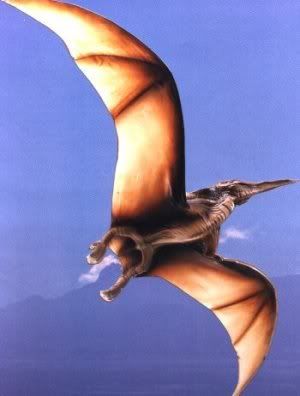1. Triceratops
Name: TriceratopsLength: 9 m, height 3 m
Mass: 12 tons
Period: Late Cretaeceous (68 million years ago)
Eat: Herbs
Triceratops means three horned face in Greek. These animals have horns as long as 1 m 2 pieces on top of his eye, and another shorter on the upper nose. Thing that most distinguishes this animal from other animals are capable of growing skull bones along the 2m, nearly one-third its body length. Fossils of these animals are found in the Americas. This animal is not expected in groups and individually. Horns serve as a position against another triceratops like deer at this time (courtship). These animals become the object of research is pretty much favored by scientists because of the many fossils were found.
2. Mammoth
 Name: Mammoth (Mammuthus primigenius)
Name: Mammoth (Mammuthus primigenius)
Length: 5 meters (up to shoulder)
Mass: 12 tons
Age: Pliocene (4.8 jt years ago)
Eating: Plants (usually in the form of a tree)
Mammoth is the ancestor of the animals we are familiar with the name of the elephant, and has a 3.3 m long tusks that are used during a fight or frighten the enemy. Mammoth fossils are often found in conditions that are still good for a very low temperature conditions. Habitat mammoth is awful regions (Russia, Siberia, and surrounding areas). Mammoth is often also called woolled woolly elephant or elephant because of fur that protects his (who is able to make it survive in extreme temperatures).
 Name: Mammoth (Mammuthus primigenius)
Name: Mammoth (Mammuthus primigenius)Length: 5 meters (up to shoulder)
Mass: 12 tons
Age: Pliocene (4.8 jt years ago)
Eating: Plants (usually in the form of a tree)
Mammoth is the ancestor of the animals we are familiar with the name of the elephant, and has a 3.3 m long tusks that are used during a fight or frighten the enemy. Mammoth fossils are often found in conditions that are still good for a very low temperature conditions. Habitat mammoth is awful regions (Russia, Siberia, and surrounding areas). Mammoth is often also called woolled woolly elephant or elephant because of fur that protects his (who is able to make it survive in extreme temperatures).
3. Velociraptor
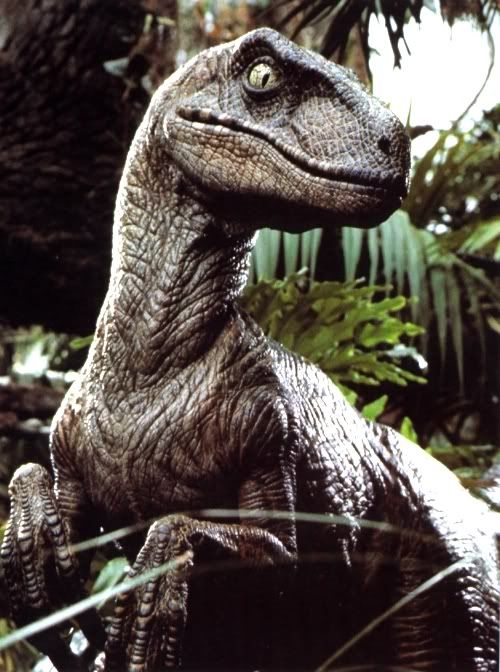 Name: Velociraptor
Name: Velociraptor
Length: 2 m (height of the body when standing 1 m)
Mass: 50 kg
Period: Late Cretaeceous
Eating: The animals are smaller than his size
Velociraptor means of high-speed thief (speedy thief). Has 30 sharp teeth and long, flat beak, and neck shape like the letter "s". Moving with the second leg (foot) was strong, and small size, these animals have characteristics similar to the cheetah. However, raptors often hunt in groups of 3-10 tail raptor. Another characteristic of raptors (in addition to the two strong legs) is the capacity of his brain that is thought to have the same ability with chimpanzees (able to communicate with fellow raptors through specific sounds). Flight speeds reaching 40 miles per hour. Fossils of Velociraptor found in Russia, Mongolia, and China.
 Name: Velociraptor
Name: VelociraptorLength: 2 m (height of the body when standing 1 m)
Mass: 50 kg
Period: Late Cretaeceous
Eating: The animals are smaller than his size
Velociraptor means of high-speed thief (speedy thief). Has 30 sharp teeth and long, flat beak, and neck shape like the letter "s". Moving with the second leg (foot) was strong, and small size, these animals have characteristics similar to the cheetah. However, raptors often hunt in groups of 3-10 tail raptor. Another characteristic of raptors (in addition to the two strong legs) is the capacity of his brain that is thought to have the same ability with chimpanzees (able to communicate with fellow raptors through specific sounds). Flight speeds reaching 40 miles per hour. Fossils of Velociraptor found in Russia, Mongolia, and China.
Length: body when standing 3m, 10m wingspan reaches
Massa: -
Age: Triassic (65.5 million years ago)
Eating: Plants and small animals such as snakes and fish
Pterodactyl comes from the Greek meaning winged lizard (winged lizards). These animals are famous for their long beaks and wings are wide expanse (reaches more than 10 m). Researchers from Ohio University found that there is one part of the brain that distinguishes this animal with other vertebrate animals. Flocculi. The proportion in the brain flocculi pterosaurs reached 7.5%, and average vertebrates only have 1-2% flocculi in his brain. This causes the vision Flocculi pterosaurs became much better. But a large proportion of this is caused more by a wide expanse of wings, because in addition associated with the eye muscles, flocculi also closely associated with sensory nerves work.
Massa: -
Age: Triassic (65.5 million years ago)
Eating: Plants and small animals such as snakes and fish
Pterodactyl comes from the Greek meaning winged lizard (winged lizards). These animals are famous for their long beaks and wings are wide expanse (reaches more than 10 m). Researchers from Ohio University found that there is one part of the brain that distinguishes this animal with other vertebrate animals. Flocculi. The proportion in the brain flocculi pterosaurs reached 7.5%, and average vertebrates only have 1-2% flocculi in his brain. This causes the vision Flocculi pterosaurs became much better. But a large proportion of this is caused more by a wide expanse of wings, because in addition associated with the eye muscles, flocculi also closely associated with sensory nerves work.
5. Smilodon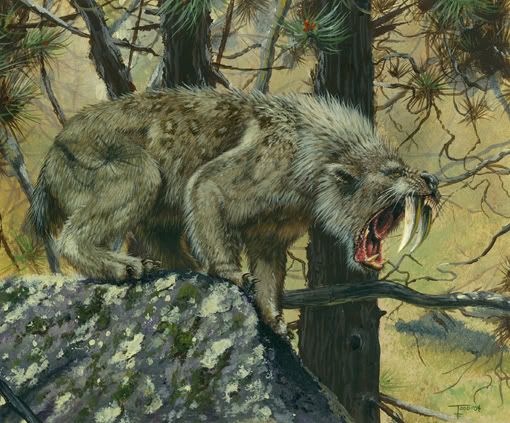 Name: Smilodon (Long-teeth cats)Length: -Mass: 55-300 kgPeriod: Megantereon (2.5 million, 500,000 years ago)Eating: plant-eating animals (bison, deer, etc..)
Name: Smilodon (Long-teeth cats)Length: -Mass: 55-300 kgPeriod: Megantereon (2.5 million, 500,000 years ago)Eating: plant-eating animals (bison, deer, etc..)
Smilodon or known as the saber-tooth cat comes from the Greek for tooth chisel, found in the Americas. Characteristic of this animal is above the long canines (17 cm). Smilodon hunted in groups like lions today. However, the group is not dominated by males, because the same body size with females. Long canine teeth that are not used to lure the pair, so the social life of animals has not been widely known. Smilodon had a body more like a bear because it resembles a bear fur, and the abdomen is wide and short.
6. TemnodontosaurusName: TemnodontosaurusLength: 9 m
Mass: 15 tonsPeriod: Early Jurassic (196 million years ago)Eating: squid and small fish
Temnodontosaurus an underwater predator that has a stunning swimming stamina, which makes it able to swim to the bottom of the sea to find their prey. Fossils found in the waters of England and Germany. The characteristics of these animals are her large, 20 cm. This animal is similar to a dolphin moment, because of their long beaks and fins are flat. 7. TyrannosaurusName: Tyrannosaurus rexLength: 12 m, height 6 mMass: 7.5 tonsPeriod: Cretaeceous (68 million years ago)Eating: plant-eating animals
 Name: Smilodon (Long-teeth cats)Length: -Mass: 55-300 kgPeriod: Megantereon (2.5 million, 500,000 years ago)Eating: plant-eating animals (bison, deer, etc..)
Name: Smilodon (Long-teeth cats)Length: -Mass: 55-300 kgPeriod: Megantereon (2.5 million, 500,000 years ago)Eating: plant-eating animals (bison, deer, etc..)Smilodon or known as the saber-tooth cat comes from the Greek for tooth chisel, found in the Americas. Characteristic of this animal is above the long canines (17 cm). Smilodon hunted in groups like lions today. However, the group is not dominated by males, because the same body size with females. Long canine teeth that are not used to lure the pair, so the social life of animals has not been widely known. Smilodon had a body more like a bear because it resembles a bear fur, and the abdomen is wide and short.
6. TemnodontosaurusName: TemnodontosaurusLength: 9 m

Mass: 15 tonsPeriod: Early Jurassic (196 million years ago)Eating: squid and small fish
Temnodontosaurus an underwater predator that has a stunning swimming stamina, which makes it able to swim to the bottom of the sea to find their prey. Fossils found in the waters of England and Germany. The characteristics of these animals are her large, 20 cm. This animal is similar to a dolphin moment, because of their long beaks and fins are flat. 7. TyrannosaurusName: Tyrannosaurus rexLength: 12 m, height 6 mMass: 7.5 tonsPeriod: Cretaeceous (68 million years ago)Eating: plant-eating animals
7. Tyrannosaurus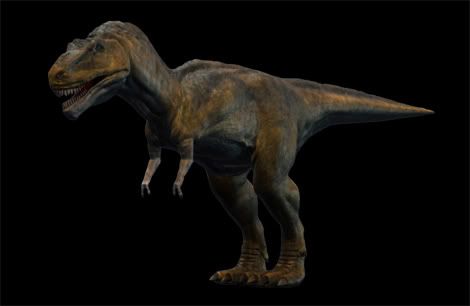 Name: Tyrannosaurus rexLength: 12 m, height 6 mMass: 7.5 tonsPeriod: Cretaeceous (68 million years ago)Eating: plant-eating animals
Name: Tyrannosaurus rexLength: 12 m, height 6 mMass: 7.5 tonsPeriod: Cretaeceous (68 million years ago)Eating: plant-eating animals
Tyrannosaurus rex in greek language support means the cruel king lizard. Just like raptors, T-rex limbed two, the neck resembles the letter "s", and has a tail as a counterweight movement. T-rex has a large skull (1.5 m) surrounded by muscle tissue strong so that makes it able to easily chew their prey. These animals are found in the Americas and the continent of Asia (Tarbosaurus). Arms of this animal is quite small, only 1 m long and have not found the actual function of this arm. Recent research (April 2008) says that T-rex has a kinship with the birds, alligators, and ostrich. Although his body is large enough, T-rex have a lot of muscles that enable it to run at speeds 40-70 km / h. Another capability of this animal is capable smell the smells of the great distances that can compared to the vultures at the moment. Until now is still a debate whether the actual T-rex eating carrion or animals that hunt.
 Name: Tyrannosaurus rexLength: 12 m, height 6 mMass: 7.5 tonsPeriod: Cretaeceous (68 million years ago)Eating: plant-eating animals
Name: Tyrannosaurus rexLength: 12 m, height 6 mMass: 7.5 tonsPeriod: Cretaeceous (68 million years ago)Eating: plant-eating animalsTyrannosaurus rex in greek language support means the cruel king lizard. Just like raptors, T-rex limbed two, the neck resembles the letter "s", and has a tail as a counterweight movement. T-rex has a large skull (1.5 m) surrounded by muscle tissue strong so that makes it able to easily chew their prey. These animals are found in the Americas and the continent of Asia (Tarbosaurus). Arms of this animal is quite small, only 1 m long and have not found the actual function of this arm. Recent research (April 2008) says that T-rex has a kinship with the birds, alligators, and ostrich. Although his body is large enough, T-rex have a lot of muscles that enable it to run at speeds 40-70 km / h. Another capability of this animal is capable smell the smells of the great distances that can compared to the vultures at the moment. Until now is still a debate whether the actual T-rex eating carrion or animals that hunt.
8. Coelacanth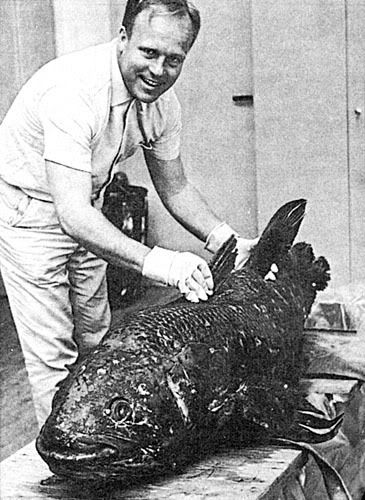 Name: coelacanth (Latimeria chalumnae)Length: 2 mMass: 80 kgPeriod: mid-Devonian (410 jt years ago)Eating: squid and small fish
Name: coelacanth (Latimeria chalumnae)Length: 2 mMass: 80 kgPeriod: mid-Devonian (410 jt years ago)Eating: squid and small fish
Coelacanth derived from the Greek word which means a hollow spine (spine / backbone sloping) believed to have gone extinct since the Cretaceous era. But the surprising discoveries continue to arrive over the discovery of this animal in the waters of Tanzania, Madagascar, Kenya, and Indonesia, precisely Bunaken National Marine Park (mantab bro!). Although these animals die after being arrested fishermen, it is believed these animals still exist and live in deep water (> 700 m). The coelacanth is one of a living fossil because it almost did not change significantly in these animals physically from time to time.
 Name: coelacanth (Latimeria chalumnae)Length: 2 mMass: 80 kgPeriod: mid-Devonian (410 jt years ago)Eating: squid and small fish
Name: coelacanth (Latimeria chalumnae)Length: 2 mMass: 80 kgPeriod: mid-Devonian (410 jt years ago)Eating: squid and small fishCoelacanth derived from the Greek word which means a hollow spine (spine / backbone sloping) believed to have gone extinct since the Cretaceous era. But the surprising discoveries continue to arrive over the discovery of this animal in the waters of Tanzania, Madagascar, Kenya, and Indonesia, precisely Bunaken National Marine Park (mantab bro!). Although these animals die after being arrested fishermen, it is believed these animals still exist and live in deep water (> 700 m). The coelacanth is one of a living fossil because it almost did not change significantly in these animals physically from time to time.
